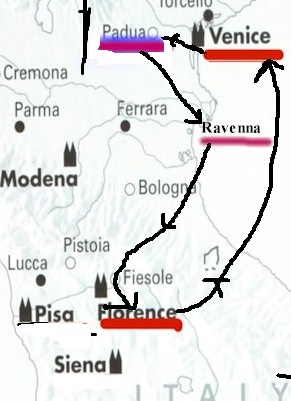CATHEDRAL QUEST
Our quest to experience the great cathedrals and churches of Europe
ITALY 2008
Day 2 Wednesday, May 8th
PADUA
We slept until 7:30 – had a good night sleep after a long days travel
yesterday. We ate a nice
“included” breakfast buffet in the hotel breakfast room.
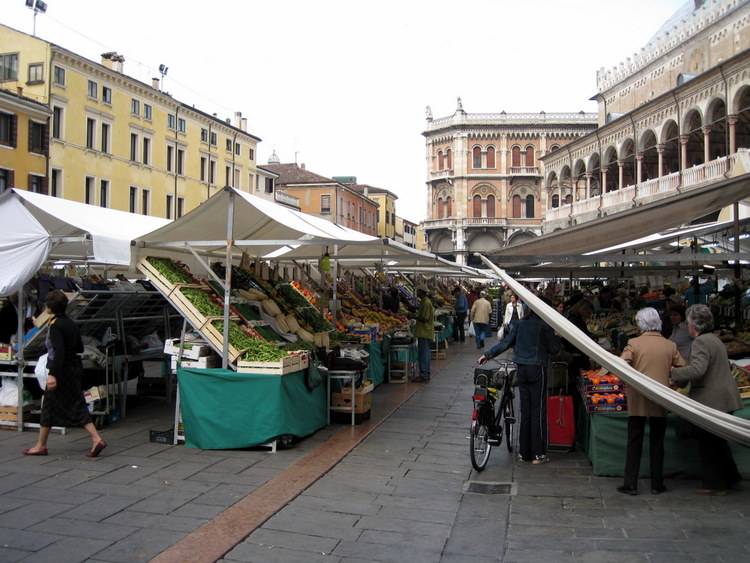 We started out on
our exploration of Padua. Around the
corner from us, where the music was last night, was a huge open vegetable and
fruit market – Piazzo delle Erbe. Late
last night it was filled with musicians and a large audience.
Somehow during the early morning hours it was converted to this market
with hundreds of stalls with every kind of produce imaginable.
The market was located next to the Palazzo
della Ragione. We visited this
building the next day so I give more information on the May 9th page.
We had forgotten to pack our tooth paste so we found a drug store and
bought some. It was an interesting
experience choosing an Italian toothpaste. We went back to the room to brush our
teeth.
We started out on
our exploration of Padua. Around the
corner from us, where the music was last night, was a huge open vegetable and
fruit market – Piazzo delle Erbe. Late
last night it was filled with musicians and a large audience.
Somehow during the early morning hours it was converted to this market
with hundreds of stalls with every kind of produce imaginable.
The market was located next to the Palazzo
della Ragione. We visited this
building the next day so I give more information on the May 9th page.
We had forgotten to pack our tooth paste so we found a drug store and
bought some. It was an interesting
experience choosing an Italian toothpaste. We went back to the room to brush our
teeth. 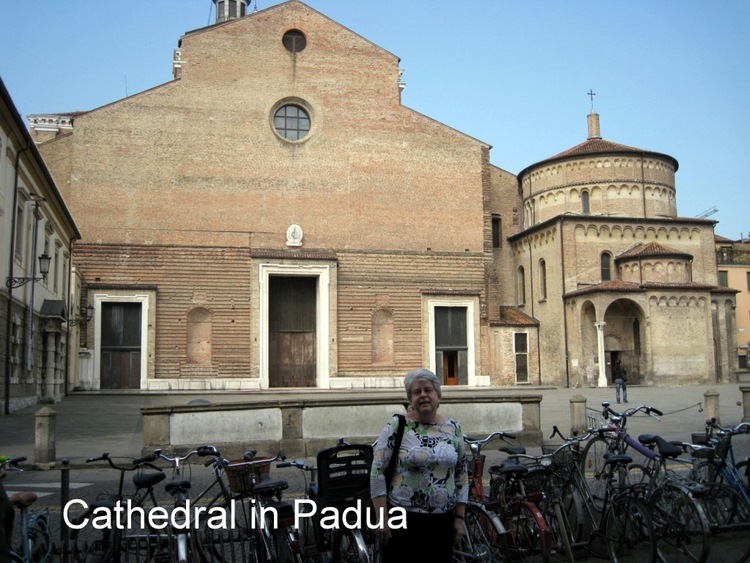
With clean teeth we
continued our exploration. It was
only a few short blocks to the Cathedral.
It was most unattractive from the outside. The
façade, which is fired brick, has never been finished. There
had been a church on the site as early as 899 which was burnt and almost totally
destroyed during the Hungarian invasion.
It was rebuilt in 1075 and 42 years later it was badly damaged by an
earthquake. After some restoration
it was decided in 1547 to rebuild it so it could meet the needs of the city.
By 1630 the right transept for completed.
The entire cathedral was finished and consecrated in 1754.
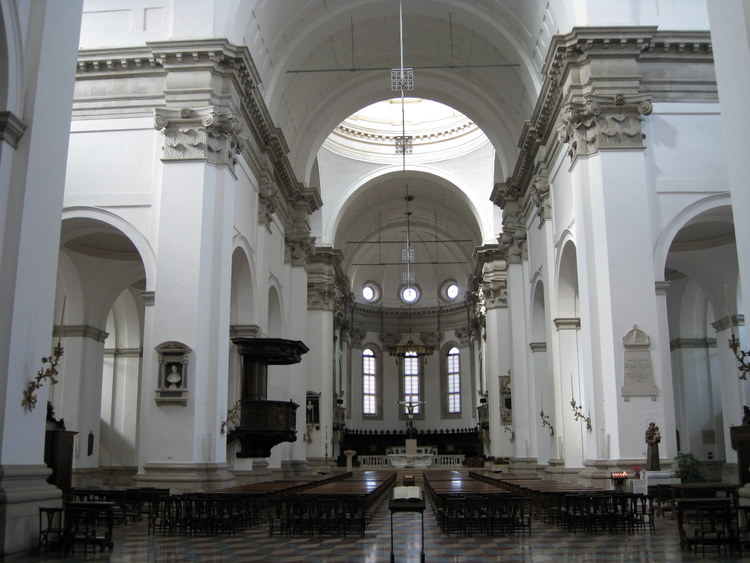 Inside was bright
and airy with a combination of baroque and modern statues.
On the left side of the nave were five chapels which included the Madonna
of the Blind and St. Gregorio Barbarigo (whose body can be seen).
On the right side were seven chapels with statues of various saints which
some relationship to the cathedral.
Inside was bright
and airy with a combination of baroque and modern statues.
On the left side of the nave were five chapels which included the Madonna
of the Blind and St. Gregorio Barbarigo (whose body can be seen).
On the right side were seven chapels with statues of various saints which
some relationship to the cathedral.
The main altar was very modern – slab of marble supported by four reclining marble angels playing musical instruments.
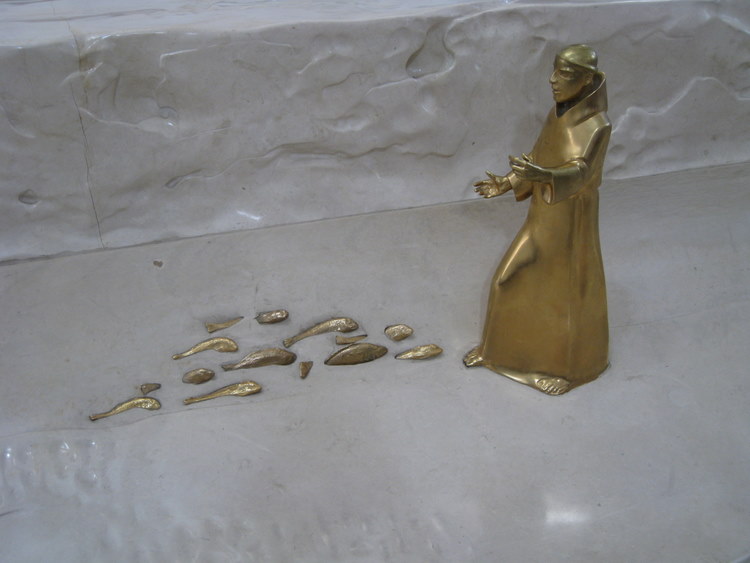
Near
the altar was a small bronze statue of St. Anthony feeding some bronze fish
shapes near his feet. I took a lot
of pictures.
Next door was the Baptistery
which was built in 1260. It was unbelievable.
The entire dome and all of the walls were frescos by Giusto de’
Menabuoi. We were not allowed to
take pictures but we bought a book and several postcards.
Our next stop was a small church called St. Nicolo, which dates back to 1088 and is considered one of oldest in Padua. St. Nicolo was the patron saint of sailors. The church underwent some restoration in 1305. The Baroque details were added between 1660 and 1680.
There was no one in the
church but us;however, while we were
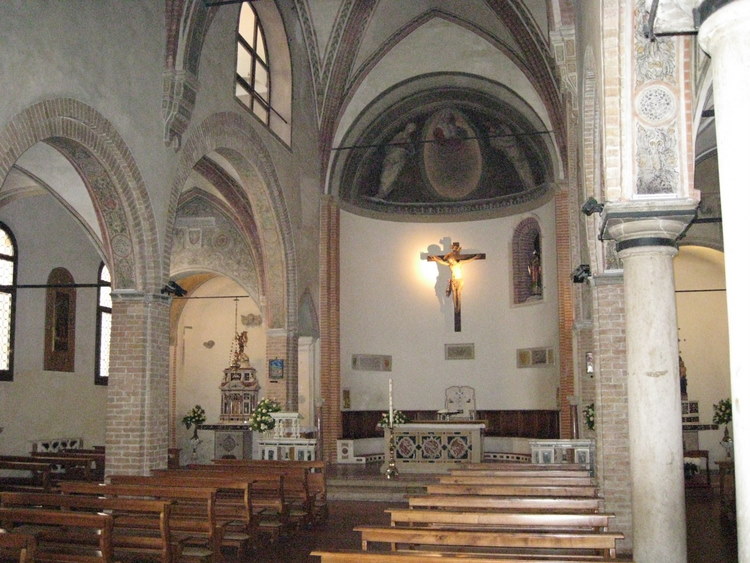 there a lady came in begging. The
church had beautiful wood carved panels which are the only examples of this kind
of art in Padua. They have been attributed to G.B. Vian, also known as Vianino
(born 1564). They are St.
Francis with signs of stigmata, the Bilocation of St. Anthony, St. Bernardine
healing a king and St. John in the desert.
Most of the churches in Italy close at noon for several hours, so we were
asked to leave.
there a lady came in begging. The
church had beautiful wood carved panels which are the only examples of this kind
of art in Padua. They have been attributed to G.B. Vian, also known as Vianino
(born 1564). They are St.
Francis with signs of stigmata, the Bilocation of St. Anthony, St. Bernardine
healing a king and St. John in the desert.
Most of the churches in Italy close at noon for several hours, so we were
asked to leave.
From there we
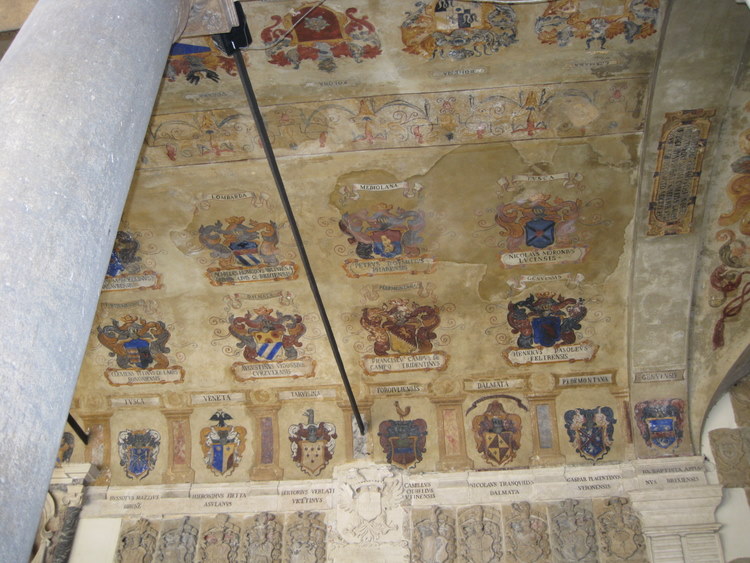 walked on the other side of Palazzo della Ragione known as Piazza
della Frutta, where there was a clothing market as large as the vegetable
market on the other side. Nearby by
was the University of Padua so we
went into the court yard. It was
very interesting with a lot of coat of arms all over the walls.
We are going back tomorrow and take a tour.
walked on the other side of Palazzo della Ragione known as Piazza
della Frutta, where there was a clothing market as large as the vegetable
market on the other side. Nearby by
was the University of Padua so we
went into the court yard. It was
very interesting with a lot of coat of arms all over the walls.
We are going back tomorrow and take a tour.
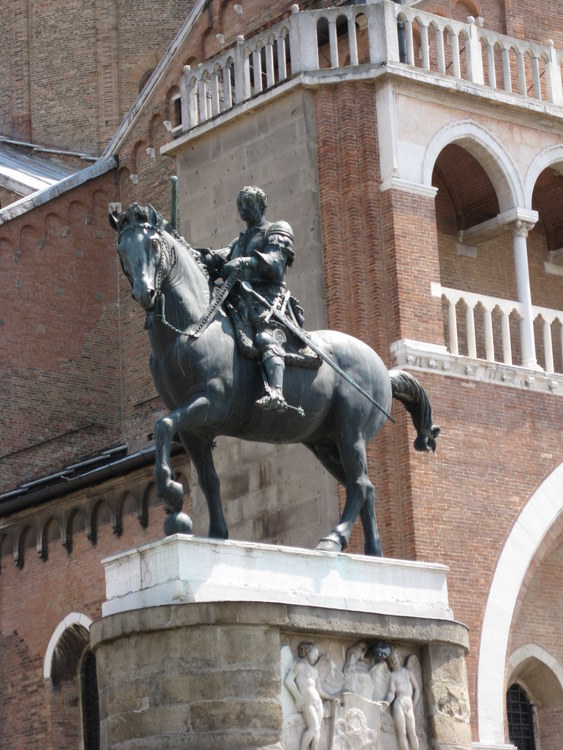

We walked about
eight blocks and found St. Anthony Bascilia. We
stopped in a pizza restaurant across the street and split a pizza, salad and
wine. We enjoyed studying the
building from outdoor café. Near
the north-east side of St. Anthony’s is Donatello’s famous statue of
Gattamelata (Erasmo da Narni) on his horse.
The basilica is
dedicated to Anthony, who was born in Lisbon around 1195.
He lived and worked in Padua for two years and died in 1231 while
traveling near Padua. The citizens
wa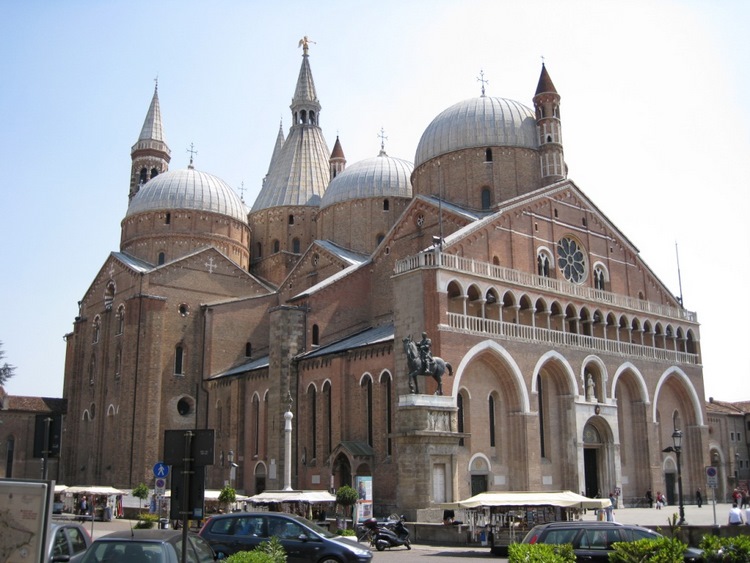 nted to bury him in Padua, so after Pope Gregory IX canonized him and the
building for the saint was started. It was completed between 1256 and 1263.
nted to bury him in Padua, so after Pope Gregory IX canonized him and the
building for the saint was started. It was completed between 1256 and 1263.
The exterior of St.
Anthony’s has four arches and three bronze doors by Camillo Boito.
Above the main door is a fresco entitled “The Saints Anthony and
Bernardino adoring the monogramme of Jesus.
Above the arches is a loggia with 17 columns.
Higher up is a rose window. There
are five domes and a central tower.
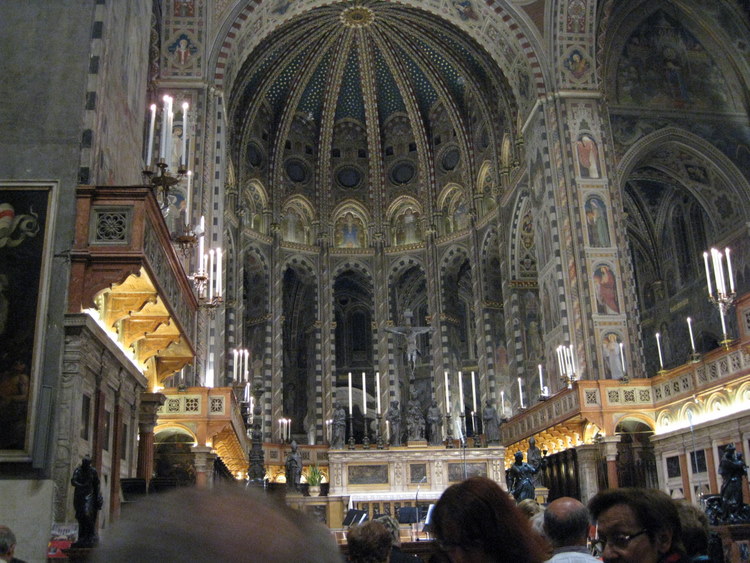 The interior has an
aisle and two naves that are separated by two pillars and two transepts.
The crucifix and the main sculptures of the altar are by Donatello.
No photos were allowed. They
were working on the chapel where St. Anthony’s tomb was so they had moved his
tomb to another chapel. Everyone
walked by the tomb and touched it. Some
people stopped to pray. St. Anthony
is a patron saint of lost things so there were lots of picture of missing people
on the walls of the chapel. We found
the gift shop and bought a book and went back to the church to use the book to
identify things.
The interior has an
aisle and two naves that are separated by two pillars and two transepts.
The crucifix and the main sculptures of the altar are by Donatello.
No photos were allowed. They
were working on the chapel where St. Anthony’s tomb was so they had moved his
tomb to another chapel. Everyone
walked by the tomb and touched it. Some
people stopped to pray. St. Anthony
is a patron saint of lost things so there were lots of picture of missing people
on the walls of the chapel. We found
the gift shop and bought a book and went back to the church to use the book to
identify things.
We saw a poster
about a free concert that night so we decided that we would come bac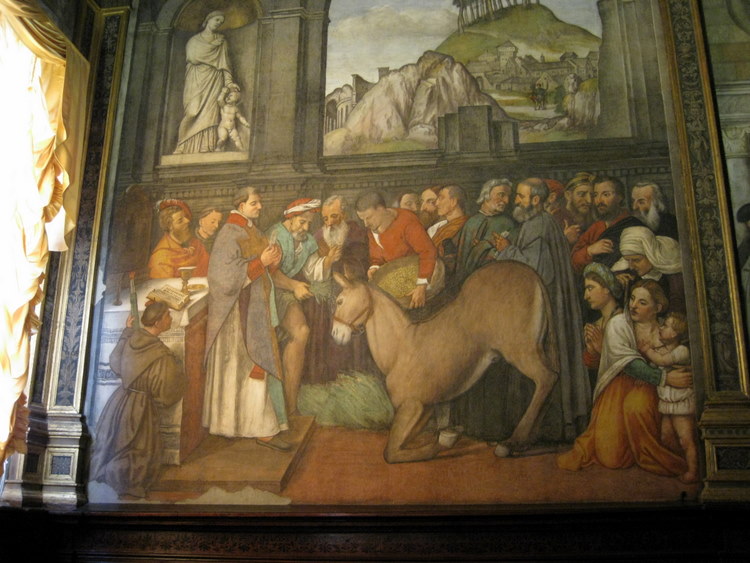 k for it.
From there we went next door to the St.
George Oratory. It was built in
1377 but was destroyed by fire. It
was rebuilt in 1837. In the school which was upstairs, all of the walls were
covered with frescos of the life of Anthony.
I don’t think we were supposed to take pictures, but there wasn’t
anyone up there but us and a couple of other visitors so I took pictures of all
the frescos. Downstairs was a
chapel with beautiful fresco of St. George, St. Catherine and others.
k for it.
From there we went next door to the St.
George Oratory. It was built in
1377 but was destroyed by fire. It
was rebuilt in 1837. In the school which was upstairs, all of the walls were
covered with frescos of the life of Anthony.
I don’t think we were supposed to take pictures, but there wasn’t
anyone up there but us and a couple of other visitors so I took pictures of all
the frescos. Downstairs was a
chapel with beautiful fresco of St. George, St. Catherine and others.
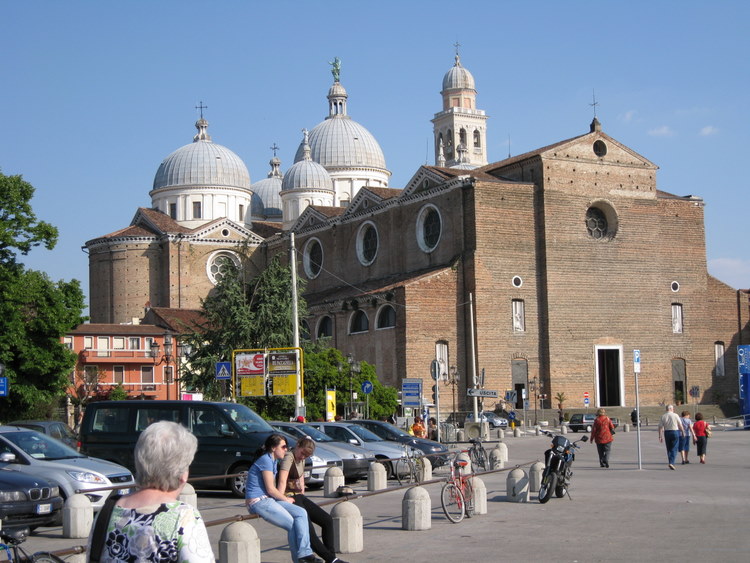 Another hike, this
time to St. Guistina (Justine)
church. It
is the 9th largest basilica in the world.
The church, like the Cathedral, had a brick unfinished façade; however
it had more character than the cathedral. It has five domes.
It was dedicated to Justine, a young girl of 16 who was condemned to
death by sentence of the Emperor Maximinian because of her Christian faith. She
was buried on Oct. 7, 304. Several
basilicas have been built on this site.
Another hike, this
time to St. Guistina (Justine)
church. It
is the 9th largest basilica in the world.
The church, like the Cathedral, had a brick unfinished façade; however
it had more character than the cathedral. It has five domes.
It was dedicated to Justine, a young girl of 16 who was condemned to
death by sentence of the Emperor Maximinian because of her Christian faith. She
was buried on Oct. 7, 304. Several
basilicas have been built on this site.
The
present church was built in the 1480s. We spent a lot of time looking around and
taking pictures (pictures allowed there). There were a number of lovely chapels
with fine art. Of particular
interest was a Chapel of Pieta with The Pieta plus statues of St. John and Mary
Magdalen by Pilippo Parodi (1689). All
five domes opened into the interior so the interior was very light. We attended
the last part of a Mass in the chapel of St. Luke which had the golden Madonna
on the wall behind the altar. The
front of the church had modern statues of the Evangelists in separate niches.
The doors had carvings about the life and death of St.
Guistina . The church was located
across from a huge park that had a lot of statues.
We started walking back to our hotel and found a side walk café.
I check the bar and the only bourbon that they had was Jack Daniel (no
Jim Beam) so I ordered it. It was a
pretty good shot for only 4.00€.
We went back to the
hotel for a few minutes to leave our books and freshen up.
Then we walked back to St. Anthony for the concert.
We stopped at a side walk café near the church.
For our supper, my wife had chicken and I had a very good steak.



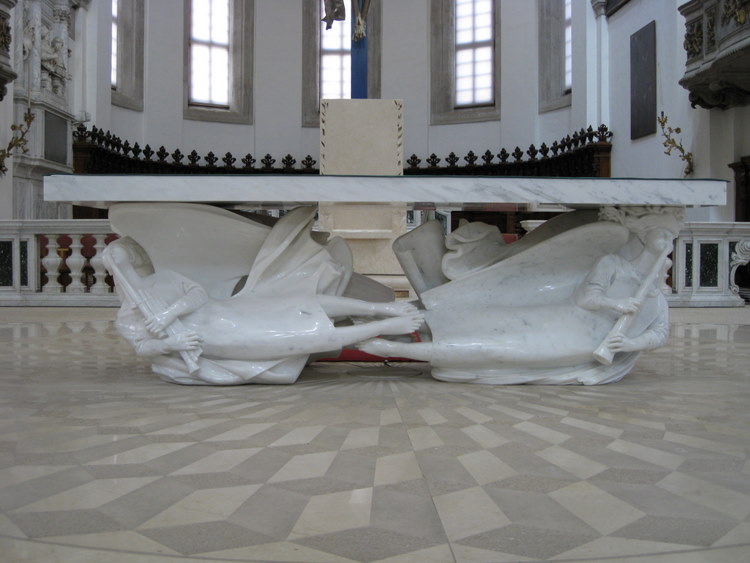
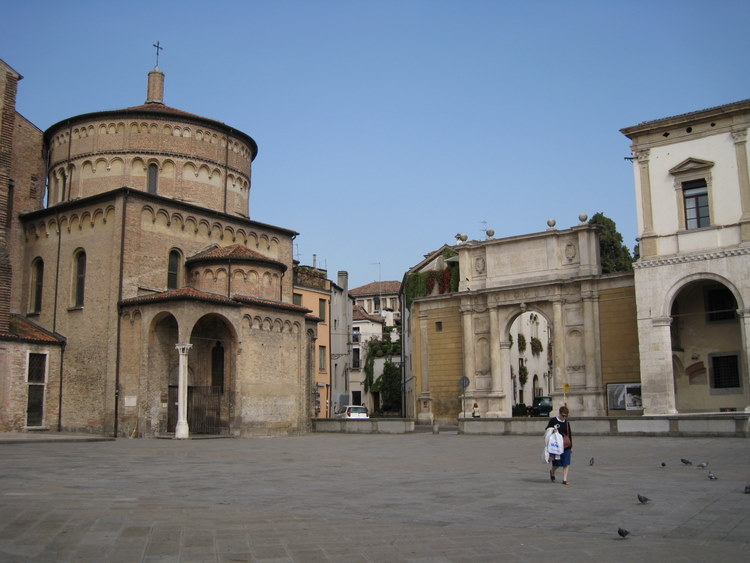
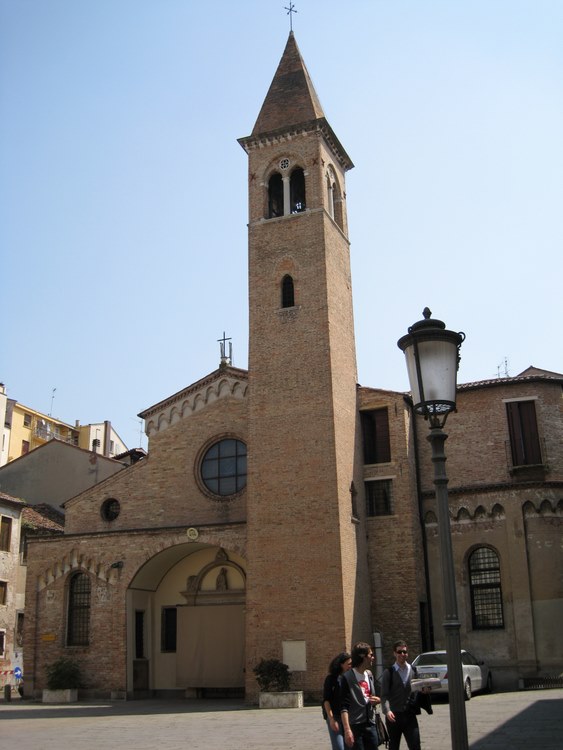
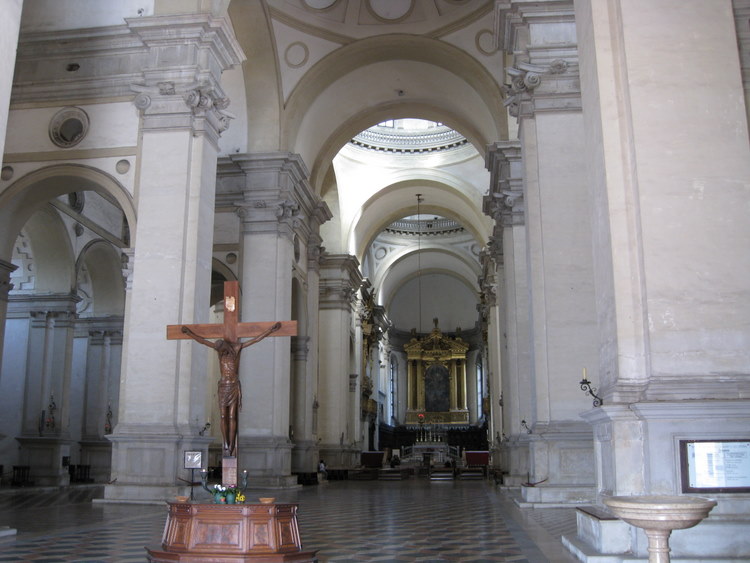
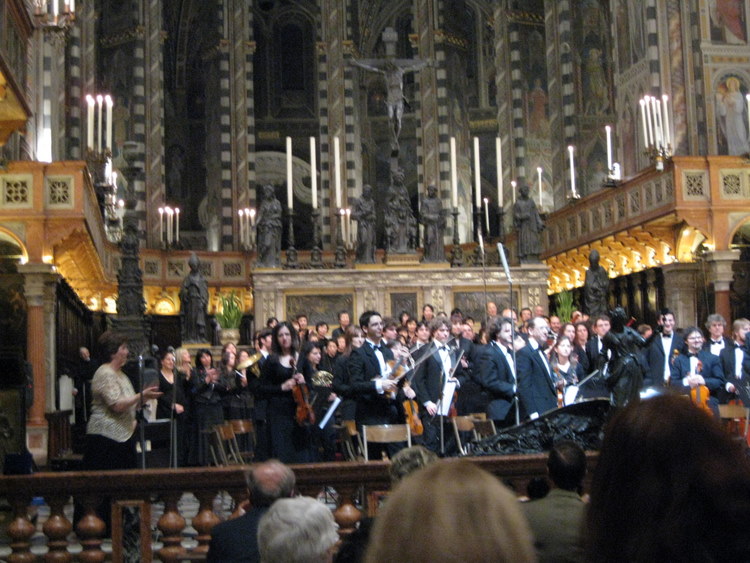 Before the concert began, I noted several people taking photos.
Before the concert began, I noted several people taking photos.